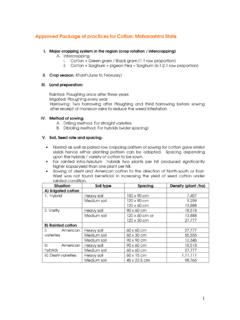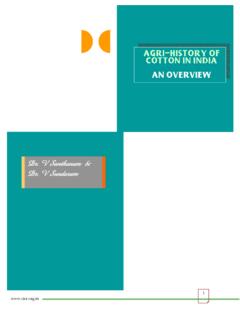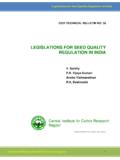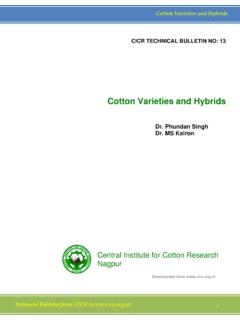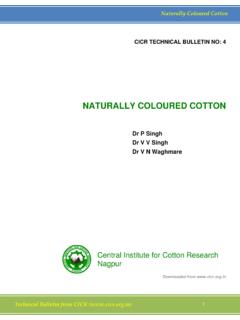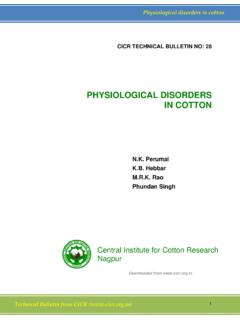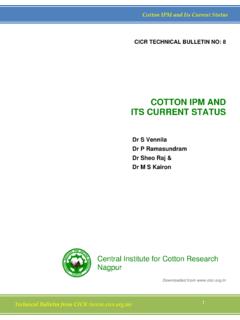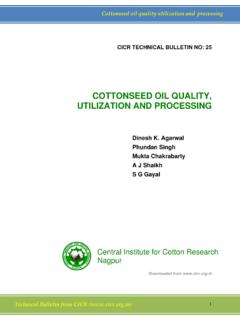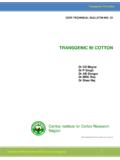Transcription of long staple ctn prod1 - Central Institute for Cotton …
1 1 2 long staple Cotton PRODUCTION IN TAMIL NADU TRAINER S TRAINING PROGRAMME Organised by Directorate of Cotton Development Ministry of Agriculture & Co operation Government of India, Mumbai September: 23 - 24, 2005 Published by Project Co-ordinator ( Cotton Improvement) & Head Central Institute for Cotton Research, Regional Station, Coimbatore - 641003. 3 long staple Cotton PRODUCTION IN TAMIL NADU Cotton is an important commercial crop of India. The city of Coimbatore is known as the Manchester of South India. Of the two thousand five hundred textile Mills in India, eight hundred textile mills exist in Tamil Nadu of which 300 are in Coimbatore District itself.
2 The Spindle capacity of this organized sector is about million. Apart from this, there are more than 700 small scale sector units which contribute not less than million spindles. These sectors on an average consume around 7 million bales of Cotton . The long and extra long staple Cotton requirement of these mills is around million bales per annum. Tamil Nadu traditionally grows Cotton in an area of about hectares and produces about million bales of Cotton and because of its climate and soil, the State is ideally suited for producing long and extra long staple cottons. The current production of extra long staple Cotton in the country is only around million bales.
3 The balance is being met through imports. However, there is a growing apprehension that with the world trade liberalization, removal of quota system and abolition of subsidy on Cotton export, the foreign cottons will become costlier and beyond the reach of Indian textile Industry. Further, the Cotton Advisory Committee has projected higher level of consumption of Cotton than production during 2005-06. Similarly, the consumption pattern in India is also expected to increase with the expansion of spinning capacity of Indian Textile Mills. With the international prices also firming up, substantial opportunity exists for the export of Indian Cotton to other countries.
4 All these things call for urgent steps to augment our long and extra long staple Cotton production in the country. Tamil Nadu is a pioneering State in the development and cultivation of long and extra long staple Cotton in the country. Release of first extra long staple G. hirsutum variety MCU 5 in 1969 is a distinct milestone. The stability and adaptability of this variety spanning across four states and four decades is due to its diverse pedigree involving genotypes from different countries and different species. India is perhaps the only country to harness G. hirsutum for spinning good 60s count yam. The release of a verticillium wilt tolerant selection MCU5 VT, in 1984 gave a further lease of life to this variety.
5 Further improvements in verticillium wilt resistance, seed Cotton yield and quality were done by hybridization with the wild species var. nervosum Leningrad strain. This was released as Surabhi in 1997. The varieties MCU 5 and Surabhi, mainly grown in both winter and summer seasons under irrigation meet the 60s Cotton requirement of the country. 4 The requirement of textile Industry for extra long staple Cotton of G. barbadense origin and capable of spinning 120s count yarn was initially met from import of Giza varieties from Egypt, Sea Island types from West Indies and Pima from USA.
6 However, pioneering research done at the Central Institute for Cotton Research, Regional Station, Coimbatore resulted in the development and release of first G. barbadense variety Sujata in 1969. However, this variety was capable of spinning only up to 100s count and also suffered from tall plant habit which made plant protection very difficult. By hybridization with the variety St Vincent from West Indies, the second barbadense Cotton Suvin capable of spinning up to 120s count was released for cultivation in 1976. Large scale cultivation of Suvin, which at one time touched 30,000 hectares in the Southern states helped the country to attain self sufficiency in Extra long staple production.
7 However, due to increased cost of cultivation, competition from other high yielding hybrids and price fluctuations at the time of harvest, the area under Suvin has been drastically reduced. However, under contract farming and through improved management practices, the area under Suvin is on the increase. Role of Heterosis or Hybrid Vigor in attaining quantumjumps in production and productivity in Cotton is known for decades. India is the only country to have successfully used this phenomenon by growing hybrids commercially on a large scale. India can feel proud of the fact than today both intra hirsutum and interspecific (G.)
8 Hirsutum x ) hybrids are under large scale cultivation in the south and Central parts of the country. Ever since the release of Hybrid-4 in 1971, as many as 40 hybrids have been released for commercial cultivation for various agro niches. Today, Cotton hybrids occupy about 45 per cent of the total Cotton area and account for 55 per cent of production. Most of the intra hirsutum hybrids released in the country belong to long staple category. We are not only self sufficient in this category but are also in a position to export a sizable quantity. With the introduction of Bt Cotton hybrids for all the three zones, the area under long staple hybrid Cotton is likely to increase further.
9 5 The first extra long staple intra hirsutum hybrid Savita capable of spinning 60' s count yam was released in 1987 from the Central Institute for Cotton Research, Regional Station, Coimbatore and this was followed by TM 1312 in 1995. Later, Private sector hybrids like RCH 2, Bunny and Mallika were released. These hybrids meet the long staple requirement of the Tamil Nadu textile mills. The long staple variety Supriya with big bolls, earliness and high ginning out turn is popularly grown in Theni and Madurai districts. Similarly, the variety MCU 13 released from Tamil Nadu Agricultural University, Coimbatore can be grown in the winter irrigated tracts.
10 These varieties are also capable of spinning up to 50 s count yam. The first interspecific (G. hirsutum x G. barbadense) hybrid, Varalaxmi was released from UAS, Dharwad. This was followed by DCH 32 in 1974. Even after three decades, these interspecific hybrids are popular in south zone states of Tarnil Nadu and Karnataka apart from certain pockets in Uttar Pradesh. The interspecific hybrids are capable of spinning up to 80 s count yarn. Due to poor adaptability of these two hybrids in Tamil Nadu, a new hybrid TCHB 213 was released from Tamil Nadu Agricultural University in 1991 and this has replaced DCH 32 in most parts of the state.
